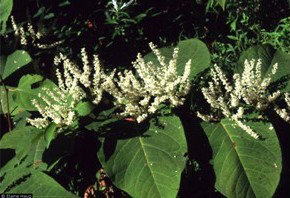The shoots of Japanese knotweed are strong enough to grow up through concrete sidewalks and parking lots.
Photo Credit: © Elaine Haug, USDA-NRCS PLANTS Database. Courtesy of Smithsonian Institution, Dept. of Systematic Biology, Botany.
Fallopia japonica
Common Name: Japanese knotweed
Other Common Names: fleeceflower, Mexican bamboo
Other Scientific Names: Polygonum cuspidatum
Plant Functional Group: Forb
Class > Order > Family: Magnoliopsida > Caryophyllales > Polygonaceae
